
A.
C.
Highfield, Tortoise Trust, Almeria, Spain
Introduction
It has long been recognised that dietary fibre content is a critical component of a healthy diet for herbivorous tortoises in captivity. In a lecture given to the British Chelonia Group annual conference in 1987, for example, the present author stated “One factor definitely identified as causing problems among captive tortoises is a lack of dietary fibre. This is a area few keepers have paid very much attention to when considering dietary matters. Our survey suggests that this situation ought to change and that dietary fibre is far more important than previously acknowledged” (Highfield, 1987). For many years, the Tortoise Trust has recommended a diet based upon “High fibre, low protein and high calcium content” ingredients (Highfield, 1986, 2004). This remains a proven and effective basis for formulating captive diets for Mediterranean and other largely herbivorous species including Geochelone pardalis (Leopard tortoises), Geochelone sulcata (African Spurred tortoises), Testudo horsfieldii (Russian tortoises) and Geochelone elegans (Indian Star tortoises) . However, despite the best efforts of keepers to formulate such diets some serious problems remain. One problem is immediately evident when comparing the faecal pellets of typical captive tortoises with those of free-ranging wild tortoises. The faecal pellets of most captive animals are looser, visibly lack comparable fibre content, and have a much higher moisture content. A second problem is that typical captive diets, even relatively well formulated diets, have a tendency to promote artificially accelerated growth rates compared to their wild counterparts. This in turn places much greater demands upon the calcium and vitamin D3 metabolism and frequently results in relatively poor bone density being achieved during growth phases in typical captive tortoises. This may manifest as uneven growth, carapace deformity and other less visible manifestations of generalised calcium and vitamin-D deficiency disorders. A number of other digestive tract disorders common in captive chelonia are also associated with lack of adequate dietary fiber (Donoghue and Langenberg, 1996). The object of this study was to examine seasonal variations in the diet of free-ranging Testudo graeca graeca in the Almeria and Murcia regions of Southern Spain, and to attempt to further understand the critical role fibre plays in maintaining a healthy digestion in tortoises, and specifically in controlling growth rates.
Diets in the wild
Seasonal fluctuations in the type and moisture content of the diet of Testudo graeca graeca are profound. As the tortoises emerge from a short hibernation in Spring, typically in mid-March (although it can occasionally be earlier), they are greeted by a gradually increasing flush of new vegetation which is intermixed with availability of older, dry vegetation, promoted by the winter rains and increasingly warm and sunny conditions.
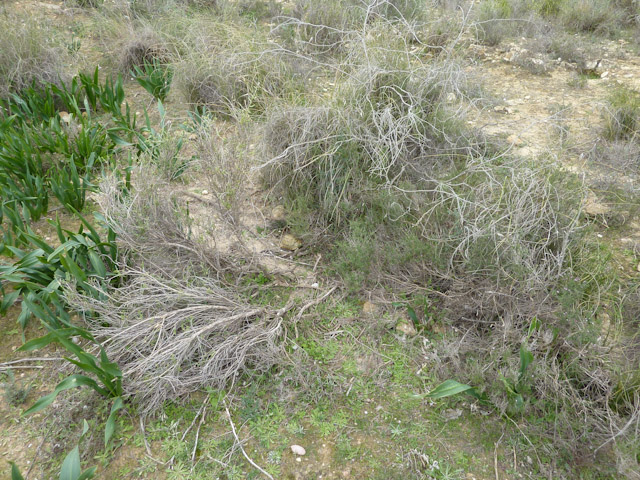
A tortoise emerges in very early spring to new growth vegetation resulting from the winter rainfall in Northern Almeria, Spain.
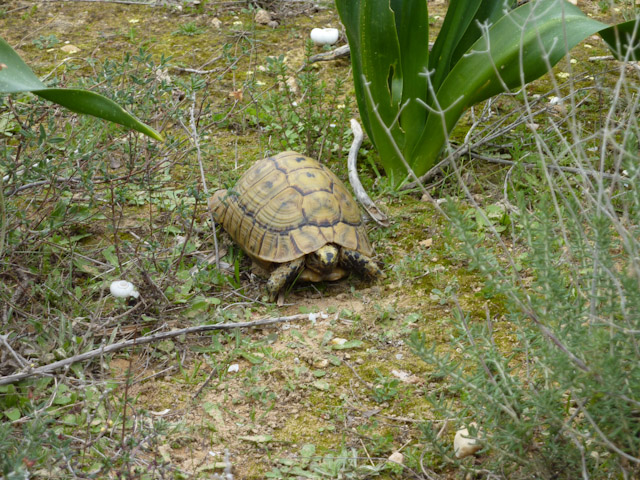
Newly emerged tortoises graze extensively on fresh, green shoots at this time of year.
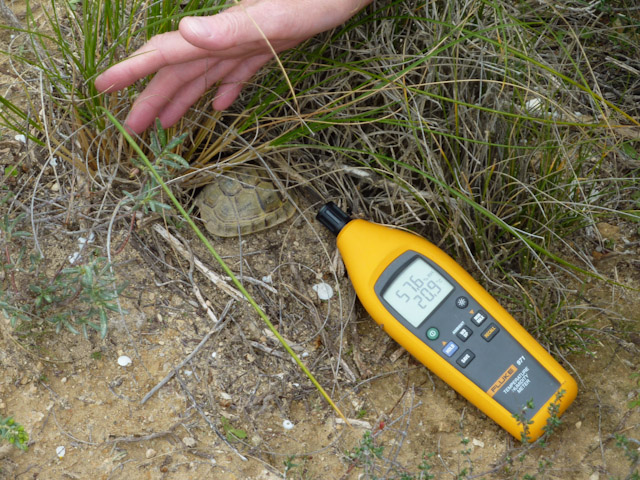
Measuring temperatures that influence digestion around a newly emerged juvenile immediately after hibernation.
This vegetation typically peaks in April-May and early June, and from there sharply declines as ambient temperatures increase to their summer peak in August, where ground surface temperatures of 60 Celsius and shade temperatures of 34 Celsius are not uncommon. Very little green vegetation survives at this time of year, rain is very infrequent, and tortoise activity ceases almost entirely. In southern, low altitude habitats Testudo graeca graeca normally estivates at this time.
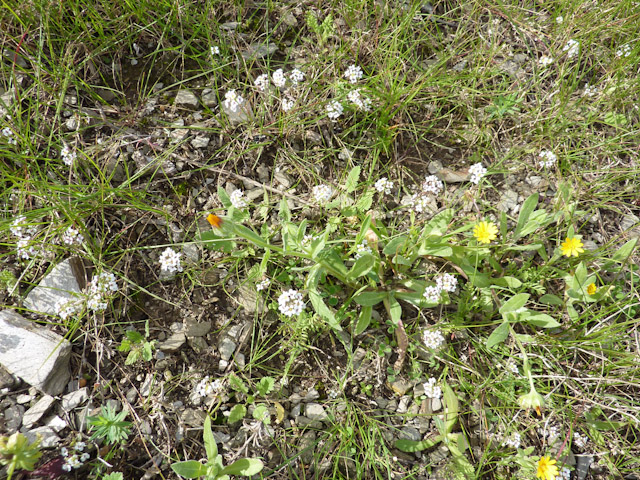
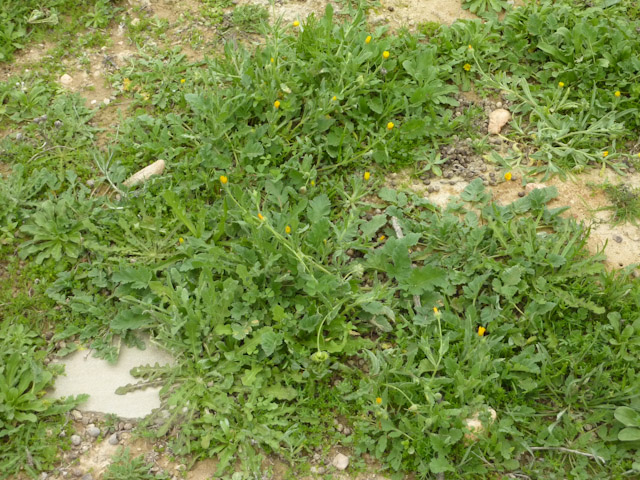
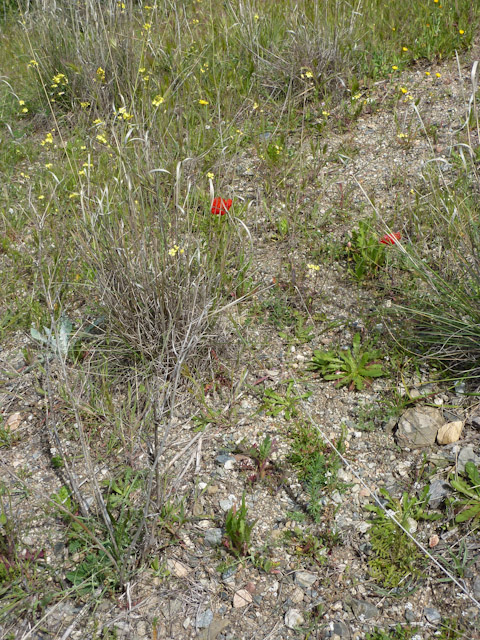
Typical vegetation in early spring
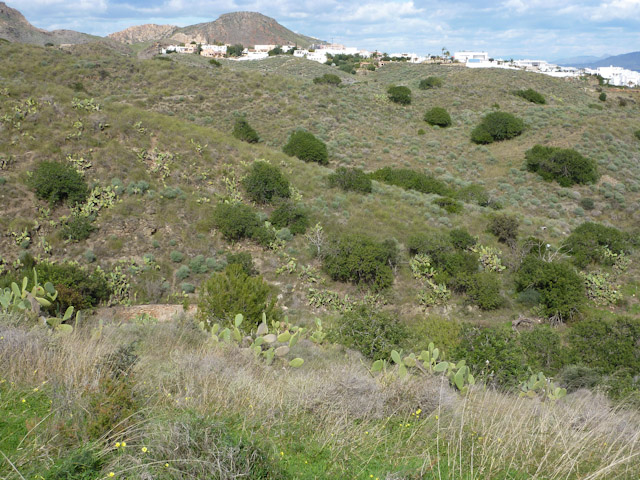
Typical habitat of Testudo graeca graeca in spring
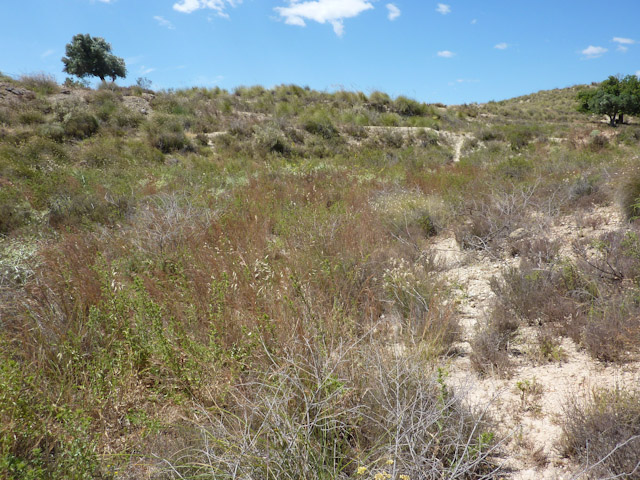
Typical vegetation by mid-June
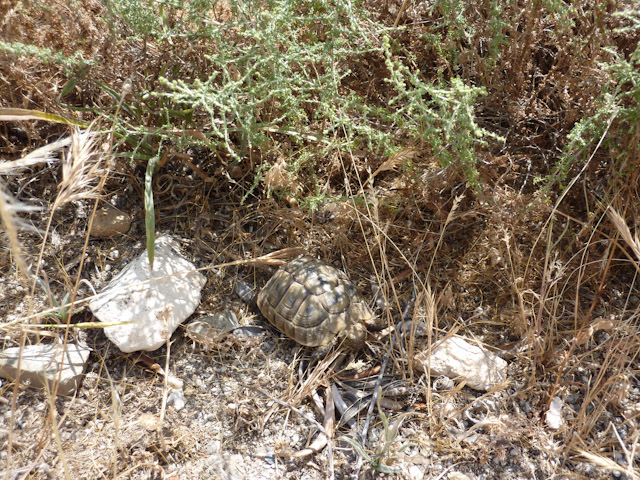
A young tortoises grazes in mid-June. By this time of year fresh green vegetation is much less abundent and the balance of the diet includes a much greater proportion of sun-dried material.
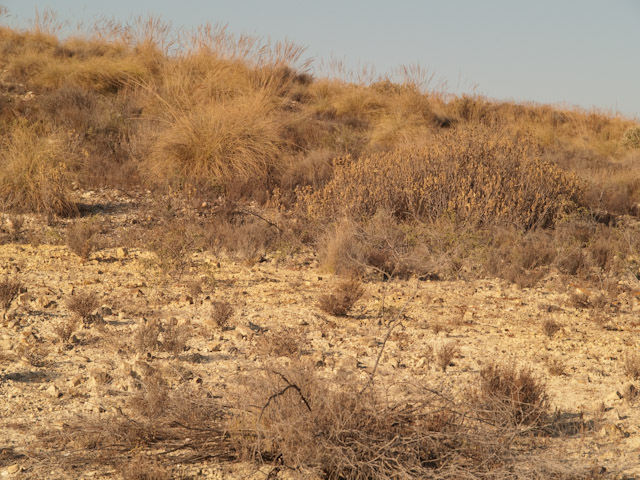
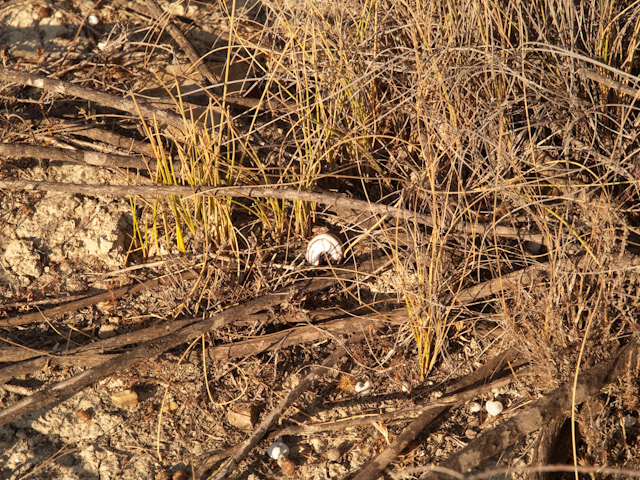
The same habitat during the hot summer dry season. Very little green vegetation remains, temperatures are extremely high, rainfall is very rare, and most tortoise populations remain innactive.
A rare exception to this lack of activity may be during rare summer thunder storms, where the sudden decease in inhospitable temperatures, a dramatic increase in ambient humidity, and the free availability of precious drinking water will prompt tortoises to emerge briefly, drinking copiously from puddles which form. Simultaneously they discharge accumulated concentrations of uric acid retained in the bladder. They also feed upon the dry vegetation present, and have been observed to take dry flowers and seeds (pers. obs). Faecal pellet analysis confirms this behaviour. It is important to stress that these rare episodes of activity may only last a day or two before inhospitably hot and dry conditions prevail again prompting a return to inactivity.
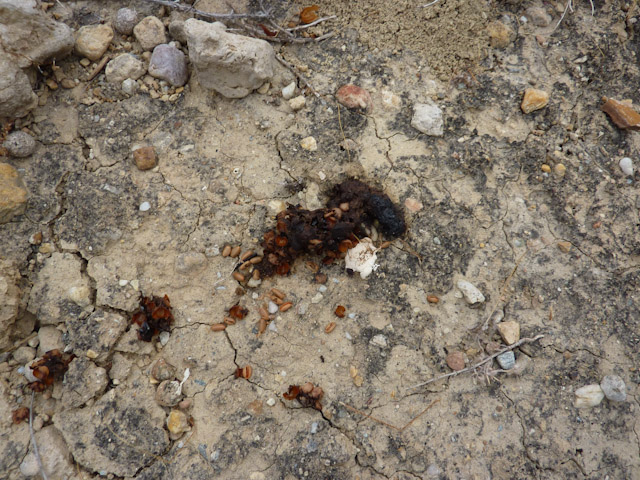
A faecal pellet discovered after an unseasonal heavy thunderstorm in July that prompted tortoises to emerge from estivation. Note the presence of urates and the high concentration of digested, partially digested and undigested seeds.

Fallen seeds of Anthyllis cytisoides, a plant which is very common in tortoise habitats in Murcia and Almeria and which was clearly the source of the seeds found in the faecal pellet (above) located in the same vicinity.
Free ranging wild tortoises consume a wide variety of plant species. Andreu (1987) identified 88 different plant species consumed by Testudo graeca graeca living in the Donana Park in Southern Spain. A comparable study undertaken during the Spring season on Testudo graeca graeca living in an overgrazed area in the Atlas Mountains in Morocco (Mouden, Slimani, etc.al., 2006) produced a range of 34 different plant species consumed, with five main species comprising 70% of the total: (Leontodon saxatilis (Asteraceae); Malva parviflora (Malvaceae); Astragalus cruciatus, Medicago hispida and Lotus arenarius (Fabaceae).
Very little new activity occurs until the end of August or early September, when in Northern Almeria and Southern Murcia, the onset of the autumn season is indicated by the sudden appearance of thunderstorms and heavy episodes of rainfall. General temperatures, however, remain quite high but are typically within the range tolerated by Testudo graeca. Tortoises resume activity. Coincidentally, the first hatchlings of the year emerge. This rainfall prompts a new, rapid explosion of fresh vegetation which the tortoises take advantage of. This new season of activity typically continues until December, when decreasing temperatures prompt a return to a brief period of hibernation.
From this it will be noted that wild Testudo graeca do not feed continually. Rather, they are only active (and feeding) at certain times of year and indeed at certain times of day. The precise times of day vary according to prevailing weather conditions. For example, in June, tortoises are often only active quite early in the morning and again, sometimes, in the late afternoon. However, in late September, they may not even emerge until almost mid-day. In early spring, renewed activity may be limited by cold, chilly days, even after emerging from hibernation (pers. obs.). The duration and timing of a typical feeding period appears to be largely dependent upon the tortoises ability to remain within a body temperature range that permits activity but precludes dangerous overheating (author’s unpublished data).
Fibre and digestibility
Some significant trends in the dietary intake of wild Testudo graeca have been noted. The first is that even where fresh, green vegetation is readily available, it is not always preferred over older, drier vegetation. Typically, a mix of the two is consumed. Seeds also typically comprise quite a significant seasonal intake. In Almeria, we noted tortoise faecal pellets with an extremely high seed content during dry periods when availability of fresh, green vegetation was severely limited. Cobo and Andreu (1988) recorded 34 different species of seeds in the faecal pellets of tortoises from Huelva province. Not all of these seeds are digested, and these authors suggest that Testudo graeca graeca may be an important seed disperser, with some seeds that have passed through the digestive tract of a tortoise showing increased viability compared to those that have not. Other seeds are completely digested or partially digested.
Hatchlings and young juveniles (defined as up to two years of age) appear to bias their diet somewhat more in the direction of fresh green leaves, grasses and flowers than do adults. However, they do still consume a wide variety of desiccated material including dry flower heads, seeds, and dry stalks. It is speculated that this may reflect the fact that the digestibility of fresh vegetation is much higher than dry vegetation, and that this may permit greater energy extraction resulting in a higher growth rate.
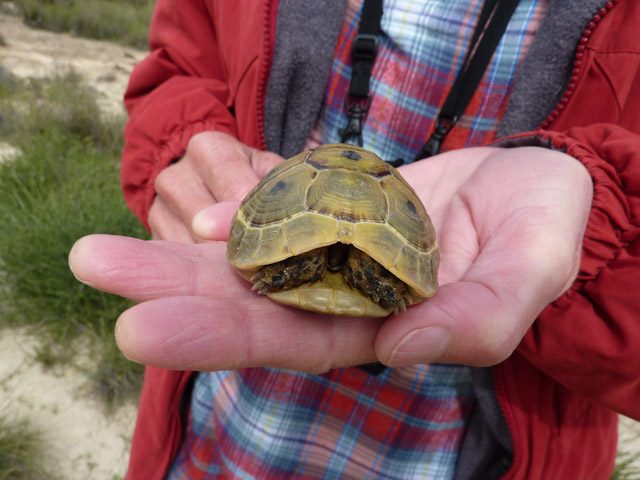
New spring growth in a wild juvenile Testudo graeca graeca in Almeria

Adults also reveal evidence of rapid growth that coincides with peak availability of the spring vegetation.
A higher growth rate may offer significant advantages in reduction of vulnerability from predators and consequent higher overall survivability. As noted previously, however, sustaining higher growth rates in while simultaneously achieving good bone density places a substantial burden upon the calcium and D3 metabolisms. Wild Testudo graeca are dependent upon receiving an adequate intake of dietary calcium from plants and from supplemental sources in the environment such as discarded snail shells, which are extremely common in tortoise habitats throughout this region. These are consumed frequently, and often feature in faecal pellet analysis (personal obs.).

Empty snail shells are extremely common in this environment and are often sought out and consumed by tortoises. This may be the source of the "white stone eating" behaviour so often commented upon by keepers of tortoises in captivity.
The vitamin D3 requirements of wild Testudo species are met almost entirely by means of synthesis in the skin from solar UV-B radiation. The precise levels of exposure received, and the other environmental conditions that play a role in this process have until recently been largely a matter of speculation, however recent work has begin to shed some light on the combination of behaviour and environmental factors involved, specifically with regard to hatchlings and young juveniles, where behaviour and exposure differs markedly from that of adults. The basking temperatures, activity patterns and UVB exposure levels during early growth phases are especially critical to long-term healthy development (Highfield, in preparation).
Tortoises (and certain herbivorous lizards, such as Iguana iguana) employ cellulolytic microbial fermentation to extract energy from their food. This process is not only dependent upon the material consumed, but also on maintaining an adequate body temperature (Bjorndal, 1987).
Cellulose occurs in the thickened cell walls of plants and is especially abundant in structures such as the stems, leaves and flowers of drought-resistant species as occur in semi-arid habitats occupied by Mediterranean Testudo species. Plant fibre consists not only of cellulose (though that it typically the major part) but also hemicellulose and lignin (Van Soest, 1994). It should be carefully noted that while most commercial foods do declare a “crude fibre” content, this is an extremely unreliable measure when considering symbiotic microorganism-based digestive processes (Robbins, 1994). It was developed to reflect how fibres behaved in mammalian digestive tracts where digestive enzymes play the most important role. In the context of herbivorous tortoises and lizards, or even cattle or rabbits it may not be entirely representative of how the material behaves once consumed. After comparing various techniques, including Crude Fibre-NFE and detergent analyses methodologies relative to the field of wildlife nutrition Robbins (op. cit) states “Current fibre analyses should be viewed with a healthy degree of skepticism”.
A major factor in influencing the rate of digestion and also the efficiency of the microbial digestive process is the particle size and length of the fibres consumed. The starch content is another highly critical and important factor.
Experiments in rabbits have shown that high fibre, large particle feeds have a more rapid gut transit time than lower fibre fine particle feeds. Even the exact same feed, with identical chemical make-up, travels through the digestive tract more rapidly as a large particle than as a fine particle (Fraga, 1990 and Gidenne, 1992).
We can usefully hypothesise a simple experiment to demonstrate this. Let us take 200 grams of coarse, dried vegetation, then divide this into four separate batches. The first batch we leave untouched. The second we grind down in a coffee grinder for 10 seconds, resulting in a very coarse mix. The third batch we grind for 20 seconds, resulting in a much finer mix, and the final batch we grind for 60 seconds resulting in a very fine powder.
The protein, gross fibre content and every other measurable analysis of these processes will remain identical, except for the particle size and length of the fibres. However, the gut transit times will differ markedly, and so will the digestive efficiency, or energy the tortoise is able to extract from the product of the different rates of grinding. Bjorndal, et.al (1990) demonstrated this effect in aquatic turtles. Even with the same raw ingredients, the growth rates achieved will be entirely different. An identical response has been demonstrated in Green iguanas (Baer, et.al, 1997). Small particle sizes would appear to have a much greater relative surface area for microbial digestion to work on (the surface to volume ratio of small vs. large particles differs substantially), therefore enabling a greater release of energy in a shorter period of time. By contrast, large, thick, and long particles are much more resistant to this breakdown process and therefore result in a lower release of energy over the same period. One very important implication of this is that it is very probable that by consuming such significant quantity of these large, coarse particles, tortoises are able to utilise this resource during inactivity periods such as estivation to provide a slow, but continual release of energy.
We can summarise the behaviour of these relative fibre particle sizes as:
a) Small, fine particles and short fibres (less than 3.0 mm): rapidly digested, rapid release of energy, stimulates high rates of fermentation and promotes high rates of growth.
b) Large, coarse particles and long fibres (>10.00 mm): slowly digested, slow release of energy, inhibits microbial fermentation and results in much slower growth.
An additional very influential factor in this is the susceptible surface area of the fibres that are available for microbial action, not the total surface area of the plant part consumed. Some plant parts very resistant to microbial attack. The most vulnerable areas are severed ends, where the cell walls are rapidly eroded by symbiotic microflora beneath the waxy, protective cutical (Bjorndal, et. al., 1990). Tortoises frequently consume whole or almost whole leaves and flowers, without chewing and without subjecting the material to enzyme pre-processing by means of saliva. The actual surface area of this type of intake available for rapid microbial digestion compared to a chopped, highly processed intake will be very much reduced, and consequently energy release will also be much less.
Careful examination in the field of sites used by estivating tortoises revealed no fresh faecal pellets. Faecal pellets were only detected after brief periods of renewed activity following thunderstorms. It appears that material remains in the gut for much longer periods during estivation, where it continues to be subject to gradual microbial breakdown. The body temperatures of 11 estivating tortoises ranged from 29 C to 31 C which is consistent with a fully active digestive system during estivation. Dietary studies on giant tortoises suggest that during dry periods they increase gut transit time by a factor of five (Hatt, 2008). Preliminary observations of Testudo graeca graeca in Spain suggest that a similar, or possibly even greater increase occurs. Further studies are ongoing into weight gain and loss during these different activity cycles (Highfield, in preparation).
The challenge of captive diets
Keeping and breeding tortoises in captivity is very popular, and a number of conservation projects also employ the technique of “head starting” captive-bred tortoises for eventual release. Provision of adequate herbivorous tortoise diets can be challenging, requiring the sourcing of a wide range of plant materials (which may suffer seasonal lack of availability) and additional supplements. Many keepers and program managers therefore seek a more convenient way of providing a satisfactory diet for their animals. A number of manufacturers have tried to address this market with pre-packaged pelleted foods. Many of these are described as “complete diets”. Stated analysis of such foods indicates that with few exceptions the crude fibre content is typically substantially less than 20% and in some cases is below 12%. Most manufacturers also label their products to indicate the maximum fibre content, and fail to divulge either the average level or the minimum level, which can prove very misleading. Studies by Hatt, Clauss, et. al. (2005) suggest that if high rates of digestibility in tortoises are to be avoided, the crude fibre content on a DM basis needs to be in the order of 30 to 40%. As we noted in the example of grinding dry vegetable matter, the crude fibre content remains the same, but digestibility varies enormously according to the size of the resulting particles and also according to how much damage has been done to the protective cuticle surrounding the plant cells. For ease of extrusion, commercial manufacturers typically utilise fine particles and softer grade fibres. Donoghue and Langenberg (op. cit.) also point out that processes used in extrusion and pelleting involve high temperatures that partially destroy labile vitamins. Such processes typically also degrade the protective integrity of the plant cells by damaging the waxy cuticle. It has already been noted (above) that the more a whole plant part is chopped, ground, degraded or processed the greater the number of cells that will be immediately exposed to immediate microbial attack. There is, therefore, a major difference in derived energy between a tortoise consuming nearly-whole plant parts and a tortoise consuming highly processed plant parts with very much more surface area available to the gut microflora.
If highly fermentable sugars and starches are added to a mix already inadequate in particle size, the digestion will accelerate rapidly. Unfortunately, many pelleted foods are extremely poor performers in this regard as they typically include a high proportion of starch-rich food industry by-products such as corn (maize) meal, soya derivatives, oats and other grain-based ingredients. Typically comprised of finely chopped short fibres, they are rapidly assimilated and are associated with promoting extremely high growth rates, unless intake is very strictly rationed, either by quantity or feeding frequency. When combined with inadequate calcium or vitamin D3 availability this is a particularly dangerous situation, and consistently, animals reared on such regimes have a very high incidence of bone developmental disorders. A secondary effect of providing excessively digestible diets is an increase in generated blood urea, that it turn places considerable demands upon the renal system. One consequence is high rates of kidney disease and gout in tortoises maintained on such diets (Highfield, 1987, MacArthur, et. al., 2004).
The typical “supermarket salad” diet is also seriously inadequate for reasons well-established elsewhere (Highfield, 2000). Such diets tend to be very low in fibre content, far too high in readily digestible starches and sugars, and typically are also very poor in available calcium content. They are also extremely high in water content. This may appear to be a good thing at first glance, but it does not approximate the fluid content of a wild diet, there are numerous anecdotal reports by keepers of an increased incidence of intestinal parasite proliferation (especially flagellates) on such diets. Many keepers and veterinarians also report a high incidence of diarrhoea where items with a high water content are offered on a regular basis. Observations over two decades in the wild in Spain, Morocco, Tunisia, Greece, Turkey and southern France instead support the view that tortoises consume a diet with very low to moderate water content, and take advantage of fresh drinking water on an opportunistic basis, from ponds, streams or during seasonal episodes of precipitation. Some highly specialised species, such as Testudo klienmanni, have also been observed to drink dew early in the morning deposited as a result of sea mists entering the periphery of the desert (Highfield, pers. obs). There is also some evidence that like other arid habitat herbivores, and some mammals, they may be able to utilise the mechanism of metabolic water generation (Highfield, 2000) to compensate for the absence of regular availability of free water in their environment.
Many keepers have attempted to overcome some of these problems by means of growing a wide variety of fresh wild flowers for their tortoises. No-one should doubt that this has been a very positive development and most keepers do report much better results than were previously being obtained on the old-style domestic “salad” diets popular some years ago. However, there is also no doubt that such diets certainly do not adequately reflect the complete spectrum of what a typical wild tortoise consumes. In particular, there is far too much emphasis upon providing a continual supply of fresh, green vegetation and fresh flowers, compared to the typical wild intake of seasonally restricted fresh vegetation and much higher reliance upon dried flowers, seed heads, coarse leaves and stalks. In addition, the species of plants grown are rarely identical to those consumed in the wild by Testudo species, especially with regard to the very tough (and hence very fibrous) species consumed by these semi-arid habitat tortoises. The gross fibre content of an average captive diet is quite likely to be in the range of up to 80% less than that consumed in the wild and the overall digestibility of these captive diets is far higher than normally encountered in nature. Nowhere is the more vividly illustrated than by examining the faecal pellets of tortoises on a natural, wild Mediterranean diet. The faecal pellets of some tropical species such as Galapagos tortoises are also extremely high in undigested fibres.
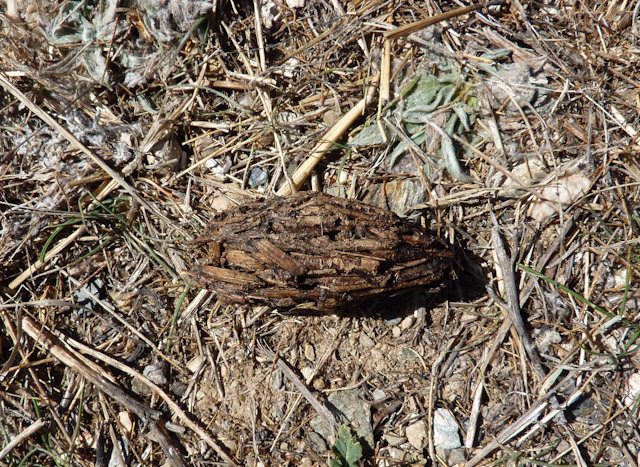
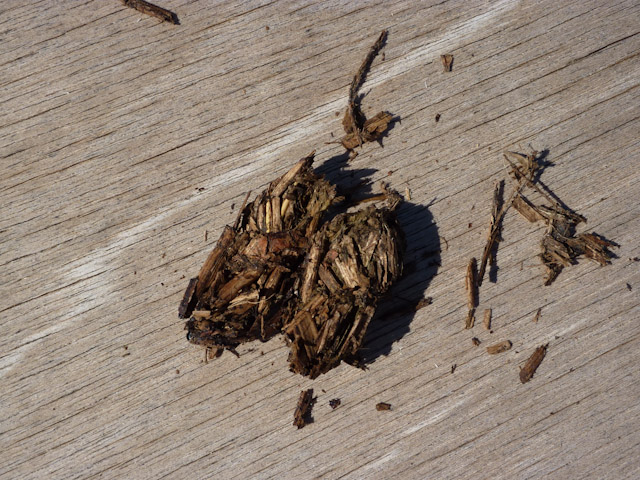
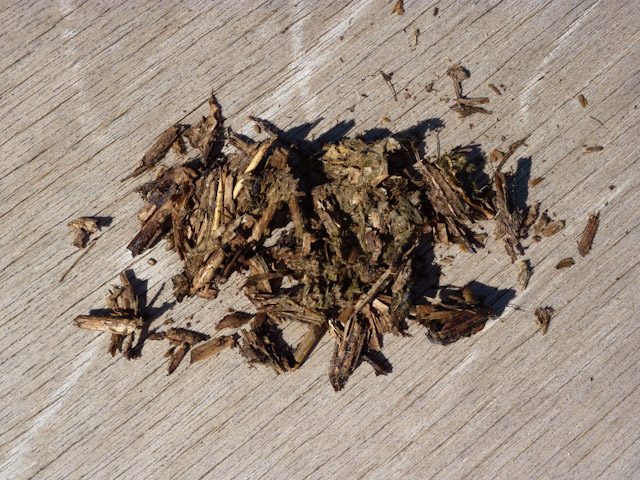
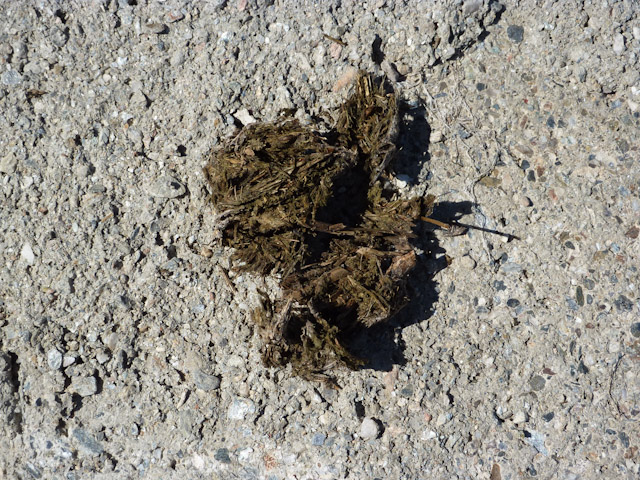
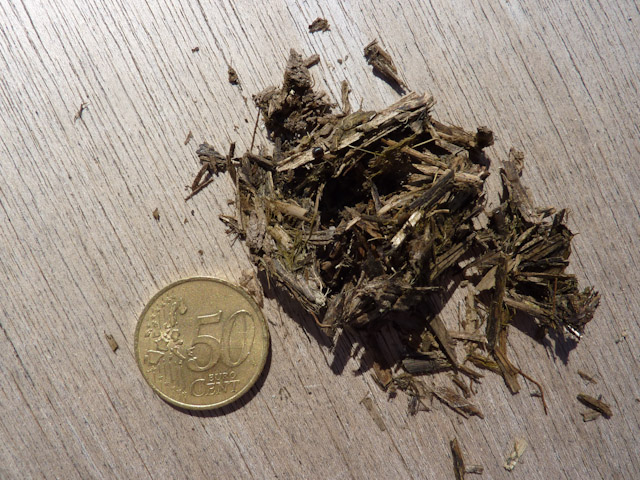
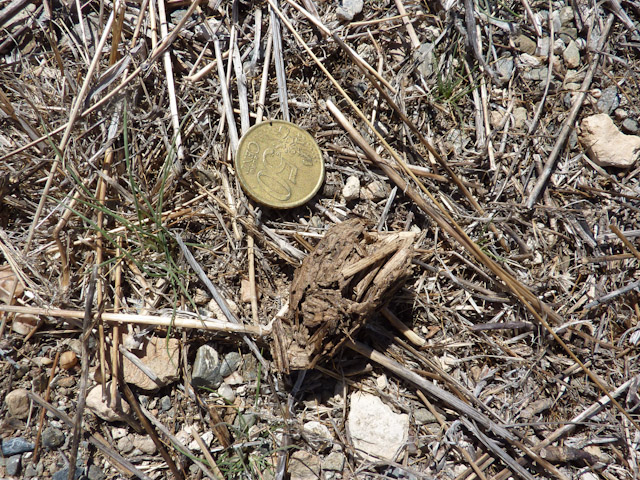
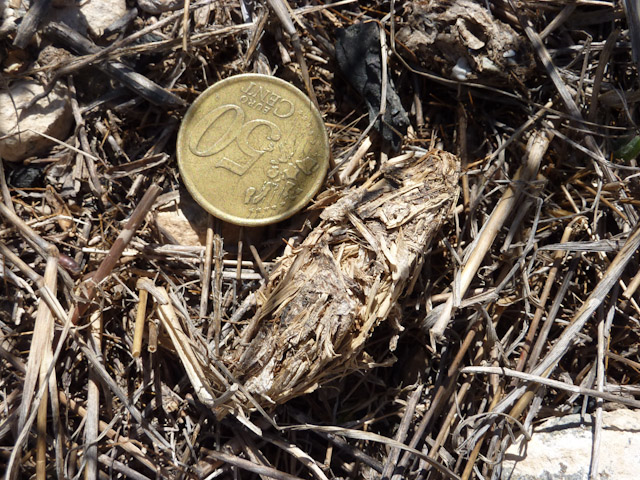
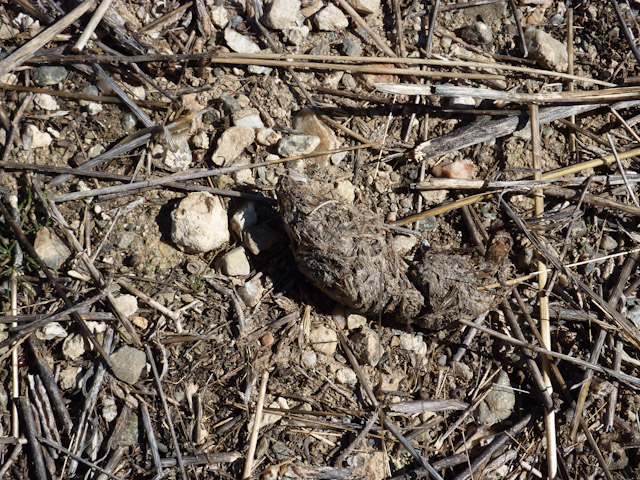
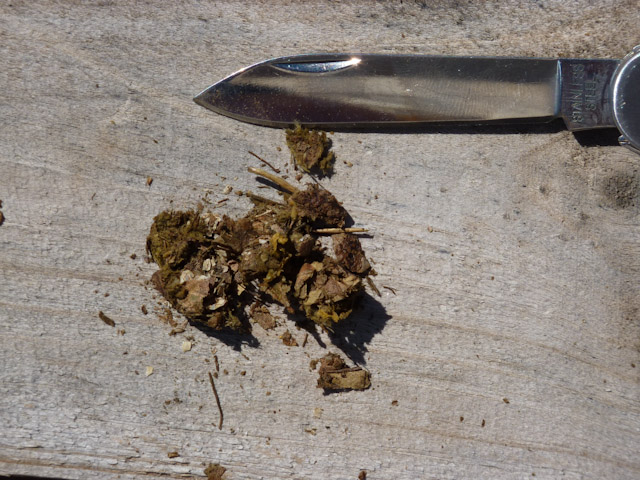
Above: examples of faecal pellets, whole and broken apart, from Testudo graeca graeca on 100% wild diets. These should be compared to the typical faecal output of captive tortoises on artificial diets.
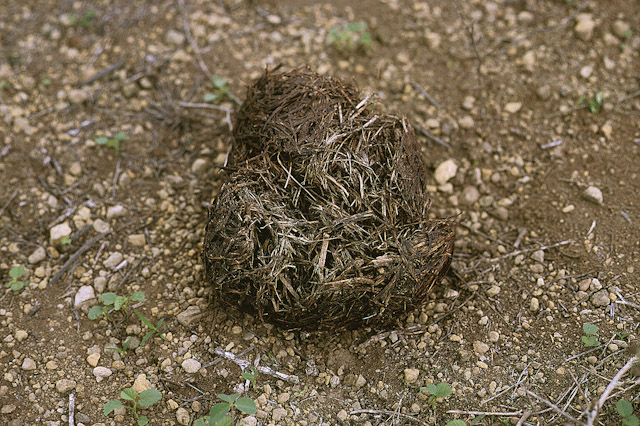
A faecal pellet from a free-ranging wild Galaagos giant tortoise in the Santa Cruz Island highlands. It also demonstrates an extremely high fibre content with low digestibility.
Discussion
Ideally, it is clear that a mix of fresh green, high fibre vegetation combined with a very high fibre (in the region of 30% on a crude fibre basis) coarse supply of dried vegetation supplied on a cyclic basis would more closely approximate the natural diet of Testudo species. Much more work needs to be done on identifying plants that are suitable for this purpose and which can be processed (dried) and preserved successfully. Presently, most captive diets rely on a far more restricted range of plants than tortoises consume in nature. By offering a greater range and variety of plant species, damaging anti-nutrient factors or toxins within individual species are dispersed, and a wider range of trace elements and other micro-nutritional components are made available (Highfield, 2000). It is, however, important to recognise that plants grown in the natural environment of the Mediterranean may possess quite a different mineral content from those grown elsewhere. An additional complicating factor is that even where plants are grown commercially and dried and packaged to the best of available technology, the preparation process is very different from that experienced in nature. There, the plants grow, die back, dry gently and are then subject to the vagaries of wind, sun and rain. They may remain like that for weeks or months before being selected by a roaming tortoise. In commercial production they are picked and processed at what is deemed a “peak” time and then protected from as much degradation as possible. This is bound to produce a very different end product from that seen in nature, even if (as is rarely the case) the very same species is employed (Lancaster, A., pers. com.)
The typical landscape of Murcia and Almeria occupied by Testudo graeca graeca is especially rich in calcium carbonate, and this is reflected in the mineral content of much of the natural vegetation (Guil, et. al.,1996). Some detailed analyses of soil types and local plant chemistry are underway and will be reported on in a future publication. We currently also lack reliable data on the typical overall moisture content of wild intake, what the impact of seasonal variations are on growth and development, and how this can be best replicated in captivity. The key objective at all times should be for growth that results in a bone density comparable to that observed in wild specimens.
While it is the case that on the surface pelleted foods may appear to be an attractive means of providing dried vegetation to captive tortoises, most - as noted - fail in a number of critical respects. The development of pelleted foods that include a high proportion of very long fibres, coarse, large particles and an appropriate protein and trace-element content should not be impossible, however. Some commercial manufacturers have already moved in that direction (Pro-Alpin and Pre-Alpin Testudo). These products are unusual in that they include a much broader diversity of plant species than typical mass-produced pellet feeds, and they omit the potentially very damaging grain and maize-based derivatives included in most other commercial offerings. They also have crude fibre and protein levels that more closely approximate that of the typical wild diet. Other manufacturers and some independent smaller scale specialist suppliers are also offering a range of dried edible herbs and “weeds” (JR Farm). Over the last few years a new mini-industry in supplying seeds, and both fresh and dry food plants to tortoise keepers has appeared, with many independent sellers of such items on sites such as Ebay. One common problem area with many of these independent suppliers, however, is the lack of adequate quality control and accurate labelling. Such products will, hopefully, continue to develop. There is room for such products, and certainly room for further developments in this field. The use of compression of a kind that results in minimal plant cell damage rather than extrusion to produce pre-packaged foods, the avoidance of high temperatures in the production process, and the inclusion of plants grown in the Mediterranean zone are some areas that should be considered.
These products are certainly a very useful addition to the options available to todays keeper and breeder who is concerned with achieving high quality, healthy growth. The best way in which these products (and others like them) can be most effectively utilised is still very much in the early stages, however. Good results are already being reported using a combination of these dried sources (e.g. the Alpin Testudo) range in combination with a well-designed, well-balanced and healthy diet of fresh plants, combined with additional calcium supplementation and adequate UV-B lighting and provision of suitable basking temperatures. More work needs to be done on establishing the ideal blend between provision of dried plant material and fresh plant material to produce consistently healthy growth, however. It is clear that in addition to controlling the gross protein level of captive tortoise diets, and ensuring adequate levels of calcium, vitamin D3 and other bone-building essentials, the control of fibre intake and digestibility is equally important.
It is only 20 or so years ago that many organisations and veterinarians advising on tortoise husbandry were still recommending a diet of lettuce, tomato, dog food and boiled eggs for captive tortoises, and the need for UVB was almost entirely ignored - so we have come a long way. We will only make further progress based upon a foundation of reliable observations of tortoises in the field, encompassing both behaviour and feeding patterns, accurate analyses of key dietary constituents, and a more complete understanding of their complex and highly variable temperature dependent digestive and vitamin D3 metabolisms.
Acknowledgements:
I would like to thank Nadine Highfield, Marcos Martinez (especially for plant identifications), Jordi Sabati and Graham Ray for invaluable assistance during the fieldwork that produced much of the data referenced above. All photos (c) by A. C. Highfield and Nadine Highfield.
References:
Andreu, A. C., 1987. Ecologia dinamica poblacional de la tortuga mora, Testudo graeca, en Donana. Thesis doctoral, University of Seville.
Baer, D. J, Oftedal, O.T., Rumpler, W. V. and Ullrey, D.E. (1997) Dietary fiber influences nutrient unilization, growth and dry matter intake of green iguanas (Iguana iguana). J. Nutrition. 127:1501-1507.
Bjorndal, K.A, Bolten, A.B, and Moore, J.E. 1990. Digestive fermentation in herbivores: effect of food particle size. Physiological Zoology. 63:710-721.
Bjorndal, K. A. (1987) Digestive Efficiency in a Temperate Herbivorous Reptile, Gopherus polyphemus. Copia 1987(3): 714-720
Cobo, M., and Andreu, A. C. (1988) Seed consumption and dispersal by the spur-thighed tortoise, Testudo graeca. Oikos 51:526-273
Fraga, M. 1990. Effect of type of fibre on the rate of passage and on the contribution of soft feces to nutrient intake of finishing rabbits. Journal of Animal Science 69:1566-74.
Donoghue, S. and Langenberg, J. (1996 Nutrition. in Reptile Medicine and Surgery (ed. Mader). W.B. Saunders.
Gidenne, T. 1992. Effect of fibre level, particle size and adaptation period on digestibility and rate of passage as measured at the ileum and in the faeces in the adult rabbit. British Journal of Nutrition. 67:133-146.
Guil, J. L, Torija, M. E., Gimenez, J. J., Rodriguez-Garcia, I., and Gimenez, A. (1996). Oxalic acid and calcium determination in Wild Edible Plants. J. Agric. Food Chem. (44):1821-1823.
Hatt, J. (2008) Raising Giant Tortoises in: Zoo and Wild Animal Medicine (eds. Fowler, M.E. and Miller, R.E.) W. B. Saunders.
Hatt, J. M., Clauss, M. and Gisler, R. (2005): Fibre digestibility in juvenile Galapagos tortoises, (Geochelone nigra) and implications for the development of captive animals. Zoo Biol (24): 185-191
Highfield, A. C. (1986) Safer Hibernation and your Tortoise. Tortoise Trust.
Highfield, A. C. (1987) Causal Factors of Mortality in Captive Collections. Testudo (2):5 17-17.
Highfield, A. C. (2000) The Tortoise and Turtle Feeding Manual. Carapace Press.
Highfield, A. C. (2004) The Tortoise Trust Guide to Tortoises and Turtles. Third Edition. Carapace Press.
Highfield, A. C. (1988) Notes on Dietary Constituents for Herbivorous Terrestrial Chelonians and their effect on Growth and Development. ASRA Journal.
MacArthur, S., Wilkinson, R. and Meyer, J. (2004) Medicine and Surgery of Tortoises and Turtles. Blackwell.
Mouden, El, E.H., Slimani, T. Kaddour, K. Ben, Lagarde, F. , Ouhammou, A., and Bonnet, X. (2006). Testudo graeca graeca feeding ecology in an arid and overgrazed zone in Morocco. JH. Arid Env. 64 (2006):422-435
Robbins, C. T. (1994) Wildlife Feeding and Nutrition. 2nd Edition. Academic Press.
Van Soest, P.J. 1994. Natural Ecology of the Ruminant. Cornell University Press, NY.
Products mentioned:
Pro and Pre Alpin Testudo
JR Farm dried herbs
(c) A. C. Highfield & Tortoise Trust 2010
From: Monographs in Chelonian Husbandry
Vol. 1 (in press, Tortoise Trust)
Introduction
It has long been recognised that dietary fibre content is a critical component of a healthy diet for herbivorous tortoises in captivity. In a lecture given to the British Chelonia Group annual conference in 1987, for example, the present author stated “One factor definitely identified as causing problems among captive tortoises is a lack of dietary fibre. This is a area few keepers have paid very much attention to when considering dietary matters. Our survey suggests that this situation ought to change and that dietary fibre is far more important than previously acknowledged” (Highfield, 1987). For many years, the Tortoise Trust has recommended a diet based upon “High fibre, low protein and high calcium content” ingredients (Highfield, 1986, 2004). This remains a proven and effective basis for formulating captive diets for Mediterranean and other largely herbivorous species including Geochelone pardalis (Leopard tortoises), Geochelone sulcata (African Spurred tortoises), Testudo horsfieldii (Russian tortoises) and Geochelone elegans (Indian Star tortoises) . However, despite the best efforts of keepers to formulate such diets some serious problems remain. One problem is immediately evident when comparing the faecal pellets of typical captive tortoises with those of free-ranging wild tortoises. The faecal pellets of most captive animals are looser, visibly lack comparable fibre content, and have a much higher moisture content. A second problem is that typical captive diets, even relatively well formulated diets, have a tendency to promote artificially accelerated growth rates compared to their wild counterparts. This in turn places much greater demands upon the calcium and vitamin D3 metabolism and frequently results in relatively poor bone density being achieved during growth phases in typical captive tortoises. This may manifest as uneven growth, carapace deformity and other less visible manifestations of generalised calcium and vitamin-D deficiency disorders. A number of other digestive tract disorders common in captive chelonia are also associated with lack of adequate dietary fiber (Donoghue and Langenberg, 1996). The object of this study was to examine seasonal variations in the diet of free-ranging Testudo graeca graeca in the Almeria and Murcia regions of Southern Spain, and to attempt to further understand the critical role fibre plays in maintaining a healthy digestion in tortoises, and specifically in controlling growth rates.
Diets in the wild
Seasonal fluctuations in the type and moisture content of the diet of Testudo graeca graeca are profound. As the tortoises emerge from a short hibernation in Spring, typically in mid-March (although it can occasionally be earlier), they are greeted by a gradually increasing flush of new vegetation which is intermixed with availability of older, dry vegetation, promoted by the winter rains and increasingly warm and sunny conditions.

A tortoise emerges in very early spring to new growth vegetation resulting from the winter rainfall in Northern Almeria, Spain.

Newly emerged tortoises graze extensively on fresh, green shoots at this time of year.

Measuring temperatures that influence digestion around a newly emerged juvenile immediately after hibernation.
This vegetation typically peaks in April-May and early June, and from there sharply declines as ambient temperatures increase to their summer peak in August, where ground surface temperatures of 60 Celsius and shade temperatures of 34 Celsius are not uncommon. Very little green vegetation survives at this time of year, rain is very infrequent, and tortoise activity ceases almost entirely. In southern, low altitude habitats Testudo graeca graeca normally estivates at this time.



Typical vegetation in early spring

Typical habitat of Testudo graeca graeca in spring

Typical vegetation by mid-June

A young tortoises grazes in mid-June. By this time of year fresh green vegetation is much less abundent and the balance of the diet includes a much greater proportion of sun-dried material.


The same habitat during the hot summer dry season. Very little green vegetation remains, temperatures are extremely high, rainfall is very rare, and most tortoise populations remain innactive.
A rare exception to this lack of activity may be during rare summer thunder storms, where the sudden decease in inhospitable temperatures, a dramatic increase in ambient humidity, and the free availability of precious drinking water will prompt tortoises to emerge briefly, drinking copiously from puddles which form. Simultaneously they discharge accumulated concentrations of uric acid retained in the bladder. They also feed upon the dry vegetation present, and have been observed to take dry flowers and seeds (pers. obs). Faecal pellet analysis confirms this behaviour. It is important to stress that these rare episodes of activity may only last a day or two before inhospitably hot and dry conditions prevail again prompting a return to inactivity.

A faecal pellet discovered after an unseasonal heavy thunderstorm in July that prompted tortoises to emerge from estivation. Note the presence of urates and the high concentration of digested, partially digested and undigested seeds.

Fallen seeds of Anthyllis cytisoides, a plant which is very common in tortoise habitats in Murcia and Almeria and which was clearly the source of the seeds found in the faecal pellet (above) located in the same vicinity.
Free ranging wild tortoises consume a wide variety of plant species. Andreu (1987) identified 88 different plant species consumed by Testudo graeca graeca living in the Donana Park in Southern Spain. A comparable study undertaken during the Spring season on Testudo graeca graeca living in an overgrazed area in the Atlas Mountains in Morocco (Mouden, Slimani, etc.al., 2006) produced a range of 34 different plant species consumed, with five main species comprising 70% of the total: (Leontodon saxatilis (Asteraceae); Malva parviflora (Malvaceae); Astragalus cruciatus, Medicago hispida and Lotus arenarius (Fabaceae).
Very little new activity occurs until the end of August or early September, when in Northern Almeria and Southern Murcia, the onset of the autumn season is indicated by the sudden appearance of thunderstorms and heavy episodes of rainfall. General temperatures, however, remain quite high but are typically within the range tolerated by Testudo graeca. Tortoises resume activity. Coincidentally, the first hatchlings of the year emerge. This rainfall prompts a new, rapid explosion of fresh vegetation which the tortoises take advantage of. This new season of activity typically continues until December, when decreasing temperatures prompt a return to a brief period of hibernation.
From this it will be noted that wild Testudo graeca do not feed continually. Rather, they are only active (and feeding) at certain times of year and indeed at certain times of day. The precise times of day vary according to prevailing weather conditions. For example, in June, tortoises are often only active quite early in the morning and again, sometimes, in the late afternoon. However, in late September, they may not even emerge until almost mid-day. In early spring, renewed activity may be limited by cold, chilly days, even after emerging from hibernation (pers. obs.). The duration and timing of a typical feeding period appears to be largely dependent upon the tortoises ability to remain within a body temperature range that permits activity but precludes dangerous overheating (author’s unpublished data).
Fibre and digestibility
Some significant trends in the dietary intake of wild Testudo graeca have been noted. The first is that even where fresh, green vegetation is readily available, it is not always preferred over older, drier vegetation. Typically, a mix of the two is consumed. Seeds also typically comprise quite a significant seasonal intake. In Almeria, we noted tortoise faecal pellets with an extremely high seed content during dry periods when availability of fresh, green vegetation was severely limited. Cobo and Andreu (1988) recorded 34 different species of seeds in the faecal pellets of tortoises from Huelva province. Not all of these seeds are digested, and these authors suggest that Testudo graeca graeca may be an important seed disperser, with some seeds that have passed through the digestive tract of a tortoise showing increased viability compared to those that have not. Other seeds are completely digested or partially digested.
Hatchlings and young juveniles (defined as up to two years of age) appear to bias their diet somewhat more in the direction of fresh green leaves, grasses and flowers than do adults. However, they do still consume a wide variety of desiccated material including dry flower heads, seeds, and dry stalks. It is speculated that this may reflect the fact that the digestibility of fresh vegetation is much higher than dry vegetation, and that this may permit greater energy extraction resulting in a higher growth rate.

New spring growth in a wild juvenile Testudo graeca graeca in Almeria

Adults also reveal evidence of rapid growth that coincides with peak availability of the spring vegetation.
A higher growth rate may offer significant advantages in reduction of vulnerability from predators and consequent higher overall survivability. As noted previously, however, sustaining higher growth rates in while simultaneously achieving good bone density places a substantial burden upon the calcium and D3 metabolisms. Wild Testudo graeca are dependent upon receiving an adequate intake of dietary calcium from plants and from supplemental sources in the environment such as discarded snail shells, which are extremely common in tortoise habitats throughout this region. These are consumed frequently, and often feature in faecal pellet analysis (personal obs.).

Empty snail shells are extremely common in this environment and are often sought out and consumed by tortoises. This may be the source of the "white stone eating" behaviour so often commented upon by keepers of tortoises in captivity.
The vitamin D3 requirements of wild Testudo species are met almost entirely by means of synthesis in the skin from solar UV-B radiation. The precise levels of exposure received, and the other environmental conditions that play a role in this process have until recently been largely a matter of speculation, however recent work has begin to shed some light on the combination of behaviour and environmental factors involved, specifically with regard to hatchlings and young juveniles, where behaviour and exposure differs markedly from that of adults. The basking temperatures, activity patterns and UVB exposure levels during early growth phases are especially critical to long-term healthy development (Highfield, in preparation).
Tortoises (and certain herbivorous lizards, such as Iguana iguana) employ cellulolytic microbial fermentation to extract energy from their food. This process is not only dependent upon the material consumed, but also on maintaining an adequate body temperature (Bjorndal, 1987).
Cellulose occurs in the thickened cell walls of plants and is especially abundant in structures such as the stems, leaves and flowers of drought-resistant species as occur in semi-arid habitats occupied by Mediterranean Testudo species. Plant fibre consists not only of cellulose (though that it typically the major part) but also hemicellulose and lignin (Van Soest, 1994). It should be carefully noted that while most commercial foods do declare a “crude fibre” content, this is an extremely unreliable measure when considering symbiotic microorganism-based digestive processes (Robbins, 1994). It was developed to reflect how fibres behaved in mammalian digestive tracts where digestive enzymes play the most important role. In the context of herbivorous tortoises and lizards, or even cattle or rabbits it may not be entirely representative of how the material behaves once consumed. After comparing various techniques, including Crude Fibre-NFE and detergent analyses methodologies relative to the field of wildlife nutrition Robbins (op. cit) states “Current fibre analyses should be viewed with a healthy degree of skepticism”.
A major factor in influencing the rate of digestion and also the efficiency of the microbial digestive process is the particle size and length of the fibres consumed. The starch content is another highly critical and important factor.
Experiments in rabbits have shown that high fibre, large particle feeds have a more rapid gut transit time than lower fibre fine particle feeds. Even the exact same feed, with identical chemical make-up, travels through the digestive tract more rapidly as a large particle than as a fine particle (Fraga, 1990 and Gidenne, 1992).
We can usefully hypothesise a simple experiment to demonstrate this. Let us take 200 grams of coarse, dried vegetation, then divide this into four separate batches. The first batch we leave untouched. The second we grind down in a coffee grinder for 10 seconds, resulting in a very coarse mix. The third batch we grind for 20 seconds, resulting in a much finer mix, and the final batch we grind for 60 seconds resulting in a very fine powder.
The protein, gross fibre content and every other measurable analysis of these processes will remain identical, except for the particle size and length of the fibres. However, the gut transit times will differ markedly, and so will the digestive efficiency, or energy the tortoise is able to extract from the product of the different rates of grinding. Bjorndal, et.al (1990) demonstrated this effect in aquatic turtles. Even with the same raw ingredients, the growth rates achieved will be entirely different. An identical response has been demonstrated in Green iguanas (Baer, et.al, 1997). Small particle sizes would appear to have a much greater relative surface area for microbial digestion to work on (the surface to volume ratio of small vs. large particles differs substantially), therefore enabling a greater release of energy in a shorter period of time. By contrast, large, thick, and long particles are much more resistant to this breakdown process and therefore result in a lower release of energy over the same period. One very important implication of this is that it is very probable that by consuming such significant quantity of these large, coarse particles, tortoises are able to utilise this resource during inactivity periods such as estivation to provide a slow, but continual release of energy.
We can summarise the behaviour of these relative fibre particle sizes as:
a) Small, fine particles and short fibres (less than 3.0 mm): rapidly digested, rapid release of energy, stimulates high rates of fermentation and promotes high rates of growth.
b) Large, coarse particles and long fibres (>10.00 mm): slowly digested, slow release of energy, inhibits microbial fermentation and results in much slower growth.
An additional very influential factor in this is the susceptible surface area of the fibres that are available for microbial action, not the total surface area of the plant part consumed. Some plant parts very resistant to microbial attack. The most vulnerable areas are severed ends, where the cell walls are rapidly eroded by symbiotic microflora beneath the waxy, protective cutical (Bjorndal, et. al., 1990). Tortoises frequently consume whole or almost whole leaves and flowers, without chewing and without subjecting the material to enzyme pre-processing by means of saliva. The actual surface area of this type of intake available for rapid microbial digestion compared to a chopped, highly processed intake will be very much reduced, and consequently energy release will also be much less.
Careful examination in the field of sites used by estivating tortoises revealed no fresh faecal pellets. Faecal pellets were only detected after brief periods of renewed activity following thunderstorms. It appears that material remains in the gut for much longer periods during estivation, where it continues to be subject to gradual microbial breakdown. The body temperatures of 11 estivating tortoises ranged from 29 C to 31 C which is consistent with a fully active digestive system during estivation. Dietary studies on giant tortoises suggest that during dry periods they increase gut transit time by a factor of five (Hatt, 2008). Preliminary observations of Testudo graeca graeca in Spain suggest that a similar, or possibly even greater increase occurs. Further studies are ongoing into weight gain and loss during these different activity cycles (Highfield, in preparation).
The challenge of captive diets
Keeping and breeding tortoises in captivity is very popular, and a number of conservation projects also employ the technique of “head starting” captive-bred tortoises for eventual release. Provision of adequate herbivorous tortoise diets can be challenging, requiring the sourcing of a wide range of plant materials (which may suffer seasonal lack of availability) and additional supplements. Many keepers and program managers therefore seek a more convenient way of providing a satisfactory diet for their animals. A number of manufacturers have tried to address this market with pre-packaged pelleted foods. Many of these are described as “complete diets”. Stated analysis of such foods indicates that with few exceptions the crude fibre content is typically substantially less than 20% and in some cases is below 12%. Most manufacturers also label their products to indicate the maximum fibre content, and fail to divulge either the average level or the minimum level, which can prove very misleading. Studies by Hatt, Clauss, et. al. (2005) suggest that if high rates of digestibility in tortoises are to be avoided, the crude fibre content on a DM basis needs to be in the order of 30 to 40%. As we noted in the example of grinding dry vegetable matter, the crude fibre content remains the same, but digestibility varies enormously according to the size of the resulting particles and also according to how much damage has been done to the protective cuticle surrounding the plant cells. For ease of extrusion, commercial manufacturers typically utilise fine particles and softer grade fibres. Donoghue and Langenberg (op. cit.) also point out that processes used in extrusion and pelleting involve high temperatures that partially destroy labile vitamins. Such processes typically also degrade the protective integrity of the plant cells by damaging the waxy cuticle. It has already been noted (above) that the more a whole plant part is chopped, ground, degraded or processed the greater the number of cells that will be immediately exposed to immediate microbial attack. There is, therefore, a major difference in derived energy between a tortoise consuming nearly-whole plant parts and a tortoise consuming highly processed plant parts with very much more surface area available to the gut microflora.
If highly fermentable sugars and starches are added to a mix already inadequate in particle size, the digestion will accelerate rapidly. Unfortunately, many pelleted foods are extremely poor performers in this regard as they typically include a high proportion of starch-rich food industry by-products such as corn (maize) meal, soya derivatives, oats and other grain-based ingredients. Typically comprised of finely chopped short fibres, they are rapidly assimilated and are associated with promoting extremely high growth rates, unless intake is very strictly rationed, either by quantity or feeding frequency. When combined with inadequate calcium or vitamin D3 availability this is a particularly dangerous situation, and consistently, animals reared on such regimes have a very high incidence of bone developmental disorders. A secondary effect of providing excessively digestible diets is an increase in generated blood urea, that it turn places considerable demands upon the renal system. One consequence is high rates of kidney disease and gout in tortoises maintained on such diets (Highfield, 1987, MacArthur, et. al., 2004).
The typical “supermarket salad” diet is also seriously inadequate for reasons well-established elsewhere (Highfield, 2000). Such diets tend to be very low in fibre content, far too high in readily digestible starches and sugars, and typically are also very poor in available calcium content. They are also extremely high in water content. This may appear to be a good thing at first glance, but it does not approximate the fluid content of a wild diet, there are numerous anecdotal reports by keepers of an increased incidence of intestinal parasite proliferation (especially flagellates) on such diets. Many keepers and veterinarians also report a high incidence of diarrhoea where items with a high water content are offered on a regular basis. Observations over two decades in the wild in Spain, Morocco, Tunisia, Greece, Turkey and southern France instead support the view that tortoises consume a diet with very low to moderate water content, and take advantage of fresh drinking water on an opportunistic basis, from ponds, streams or during seasonal episodes of precipitation. Some highly specialised species, such as Testudo klienmanni, have also been observed to drink dew early in the morning deposited as a result of sea mists entering the periphery of the desert (Highfield, pers. obs). There is also some evidence that like other arid habitat herbivores, and some mammals, they may be able to utilise the mechanism of metabolic water generation (Highfield, 2000) to compensate for the absence of regular availability of free water in their environment.
Many keepers have attempted to overcome some of these problems by means of growing a wide variety of fresh wild flowers for their tortoises. No-one should doubt that this has been a very positive development and most keepers do report much better results than were previously being obtained on the old-style domestic “salad” diets popular some years ago. However, there is also no doubt that such diets certainly do not adequately reflect the complete spectrum of what a typical wild tortoise consumes. In particular, there is far too much emphasis upon providing a continual supply of fresh, green vegetation and fresh flowers, compared to the typical wild intake of seasonally restricted fresh vegetation and much higher reliance upon dried flowers, seed heads, coarse leaves and stalks. In addition, the species of plants grown are rarely identical to those consumed in the wild by Testudo species, especially with regard to the very tough (and hence very fibrous) species consumed by these semi-arid habitat tortoises. The gross fibre content of an average captive diet is quite likely to be in the range of up to 80% less than that consumed in the wild and the overall digestibility of these captive diets is far higher than normally encountered in nature. Nowhere is the more vividly illustrated than by examining the faecal pellets of tortoises on a natural, wild Mediterranean diet. The faecal pellets of some tropical species such as Galapagos tortoises are also extremely high in undigested fibres.









Above: examples of faecal pellets, whole and broken apart, from Testudo graeca graeca on 100% wild diets. These should be compared to the typical faecal output of captive tortoises on artificial diets.

A faecal pellet from a free-ranging wild Galaagos giant tortoise in the Santa Cruz Island highlands. It also demonstrates an extremely high fibre content with low digestibility.
Discussion
Ideally, it is clear that a mix of fresh green, high fibre vegetation combined with a very high fibre (in the region of 30% on a crude fibre basis) coarse supply of dried vegetation supplied on a cyclic basis would more closely approximate the natural diet of Testudo species. Much more work needs to be done on identifying plants that are suitable for this purpose and which can be processed (dried) and preserved successfully. Presently, most captive diets rely on a far more restricted range of plants than tortoises consume in nature. By offering a greater range and variety of plant species, damaging anti-nutrient factors or toxins within individual species are dispersed, and a wider range of trace elements and other micro-nutritional components are made available (Highfield, 2000). It is, however, important to recognise that plants grown in the natural environment of the Mediterranean may possess quite a different mineral content from those grown elsewhere. An additional complicating factor is that even where plants are grown commercially and dried and packaged to the best of available technology, the preparation process is very different from that experienced in nature. There, the plants grow, die back, dry gently and are then subject to the vagaries of wind, sun and rain. They may remain like that for weeks or months before being selected by a roaming tortoise. In commercial production they are picked and processed at what is deemed a “peak” time and then protected from as much degradation as possible. This is bound to produce a very different end product from that seen in nature, even if (as is rarely the case) the very same species is employed (Lancaster, A., pers. com.)
The typical landscape of Murcia and Almeria occupied by Testudo graeca graeca is especially rich in calcium carbonate, and this is reflected in the mineral content of much of the natural vegetation (Guil, et. al.,1996). Some detailed analyses of soil types and local plant chemistry are underway and will be reported on in a future publication. We currently also lack reliable data on the typical overall moisture content of wild intake, what the impact of seasonal variations are on growth and development, and how this can be best replicated in captivity. The key objective at all times should be for growth that results in a bone density comparable to that observed in wild specimens.
While it is the case that on the surface pelleted foods may appear to be an attractive means of providing dried vegetation to captive tortoises, most - as noted - fail in a number of critical respects. The development of pelleted foods that include a high proportion of very long fibres, coarse, large particles and an appropriate protein and trace-element content should not be impossible, however. Some commercial manufacturers have already moved in that direction (Pro-Alpin and Pre-Alpin Testudo). These products are unusual in that they include a much broader diversity of plant species than typical mass-produced pellet feeds, and they omit the potentially very damaging grain and maize-based derivatives included in most other commercial offerings. They also have crude fibre and protein levels that more closely approximate that of the typical wild diet. Other manufacturers and some independent smaller scale specialist suppliers are also offering a range of dried edible herbs and “weeds” (JR Farm). Over the last few years a new mini-industry in supplying seeds, and both fresh and dry food plants to tortoise keepers has appeared, with many independent sellers of such items on sites such as Ebay. One common problem area with many of these independent suppliers, however, is the lack of adequate quality control and accurate labelling. Such products will, hopefully, continue to develop. There is room for such products, and certainly room for further developments in this field. The use of compression of a kind that results in minimal plant cell damage rather than extrusion to produce pre-packaged foods, the avoidance of high temperatures in the production process, and the inclusion of plants grown in the Mediterranean zone are some areas that should be considered.
These products are certainly a very useful addition to the options available to todays keeper and breeder who is concerned with achieving high quality, healthy growth. The best way in which these products (and others like them) can be most effectively utilised is still very much in the early stages, however. Good results are already being reported using a combination of these dried sources (e.g. the Alpin Testudo) range in combination with a well-designed, well-balanced and healthy diet of fresh plants, combined with additional calcium supplementation and adequate UV-B lighting and provision of suitable basking temperatures. More work needs to be done on establishing the ideal blend between provision of dried plant material and fresh plant material to produce consistently healthy growth, however. It is clear that in addition to controlling the gross protein level of captive tortoise diets, and ensuring adequate levels of calcium, vitamin D3 and other bone-building essentials, the control of fibre intake and digestibility is equally important.
It is only 20 or so years ago that many organisations and veterinarians advising on tortoise husbandry were still recommending a diet of lettuce, tomato, dog food and boiled eggs for captive tortoises, and the need for UVB was almost entirely ignored - so we have come a long way. We will only make further progress based upon a foundation of reliable observations of tortoises in the field, encompassing both behaviour and feeding patterns, accurate analyses of key dietary constituents, and a more complete understanding of their complex and highly variable temperature dependent digestive and vitamin D3 metabolisms.
Acknowledgements:
I would like to thank Nadine Highfield, Marcos Martinez (especially for plant identifications), Jordi Sabati and Graham Ray for invaluable assistance during the fieldwork that produced much of the data referenced above. All photos (c) by A. C. Highfield and Nadine Highfield.
References:
Andreu, A. C., 1987. Ecologia dinamica poblacional de la tortuga mora, Testudo graeca, en Donana. Thesis doctoral, University of Seville.
Baer, D. J, Oftedal, O.T., Rumpler, W. V. and Ullrey, D.E. (1997) Dietary fiber influences nutrient unilization, growth and dry matter intake of green iguanas (Iguana iguana). J. Nutrition. 127:1501-1507.
Bjorndal, K.A, Bolten, A.B, and Moore, J.E. 1990. Digestive fermentation in herbivores: effect of food particle size. Physiological Zoology. 63:710-721.
Bjorndal, K. A. (1987) Digestive Efficiency in a Temperate Herbivorous Reptile, Gopherus polyphemus. Copia 1987(3): 714-720
Cobo, M., and Andreu, A. C. (1988) Seed consumption and dispersal by the spur-thighed tortoise, Testudo graeca. Oikos 51:526-273
Fraga, M. 1990. Effect of type of fibre on the rate of passage and on the contribution of soft feces to nutrient intake of finishing rabbits. Journal of Animal Science 69:1566-74.
Donoghue, S. and Langenberg, J. (1996 Nutrition. in Reptile Medicine and Surgery (ed. Mader). W.B. Saunders.
Gidenne, T. 1992. Effect of fibre level, particle size and adaptation period on digestibility and rate of passage as measured at the ileum and in the faeces in the adult rabbit. British Journal of Nutrition. 67:133-146.
Guil, J. L, Torija, M. E., Gimenez, J. J., Rodriguez-Garcia, I., and Gimenez, A. (1996). Oxalic acid and calcium determination in Wild Edible Plants. J. Agric. Food Chem. (44):1821-1823.
Hatt, J. (2008) Raising Giant Tortoises in: Zoo and Wild Animal Medicine (eds. Fowler, M.E. and Miller, R.E.) W. B. Saunders.
Hatt, J. M., Clauss, M. and Gisler, R. (2005): Fibre digestibility in juvenile Galapagos tortoises, (Geochelone nigra) and implications for the development of captive animals. Zoo Biol (24): 185-191
Highfield, A. C. (1986) Safer Hibernation and your Tortoise. Tortoise Trust.
Highfield, A. C. (1987) Causal Factors of Mortality in Captive Collections. Testudo (2):5 17-17.
Highfield, A. C. (2000) The Tortoise and Turtle Feeding Manual. Carapace Press.
Highfield, A. C. (2004) The Tortoise Trust Guide to Tortoises and Turtles. Third Edition. Carapace Press.
Highfield, A. C. (1988) Notes on Dietary Constituents for Herbivorous Terrestrial Chelonians and their effect on Growth and Development. ASRA Journal.
MacArthur, S., Wilkinson, R. and Meyer, J. (2004) Medicine and Surgery of Tortoises and Turtles. Blackwell.
Mouden, El, E.H., Slimani, T. Kaddour, K. Ben, Lagarde, F. , Ouhammou, A., and Bonnet, X. (2006). Testudo graeca graeca feeding ecology in an arid and overgrazed zone in Morocco. JH. Arid Env. 64 (2006):422-435
Robbins, C. T. (1994) Wildlife Feeding and Nutrition. 2nd Edition. Academic Press.
Van Soest, P.J. 1994. Natural Ecology of the Ruminant. Cornell University Press, NY.
Products mentioned:
Pro and Pre Alpin Testudo
JR Farm dried herbs
(c) A. C. Highfield & Tortoise Trust 2010